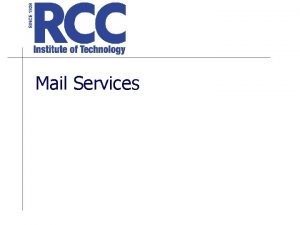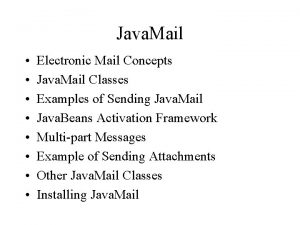January 25 Did you get mail from ChunFa









- Slides: 9

January 25 • Did you get mail from Chun-Fa about assignment grades? • Assignment 3 posted due Feb 1. • Read 3. 1 through 3. 4 for next Tuesday 30 January • Only 3 more lectures before the first exam coming up February 8. • Maxima (was macsyma) is a nice FREE symbolic algebra package http: //www. ma. utexas. edu/users/wfs/maxima. html 12/14/2021 Comp 120 Spring 2001 1

Benchmarks • • • Performance best determined by running a real application – Use programs typical of expected workload – Or, typical of expected class of applications e. g. , compilers/editors, scientific applications, graphics, etc. Synthetic benchmarks (Dhrystone, Whetstone) – nice for architects and designers – easy to standardize – Easy to abuse SPEC (System Performance Evaluation Cooperative) – companies have agreed on a set of real program and inputs – can still be abused (Intel’s “other” bug) – valuable indicator of performance (and compiler technology) 12/14/2021 Comp 120 Spring 2001 2

SPEC ‘ 89 • Compiler “enhancements” and performance 12/14/2021 Comp 120 Spring 2001 3

SPEC ‘ 95 12/14/2021 Comp 120 Spring 2001 4

SPEC ‘ 95 Does doubling the clock rate double the performance? Can a machine with a slower clock rate have better performance? 12/14/2021 Comp 120 Spring 2001 5

Amdahl's Law Execution Time After Improvement = Execution Time Unaffected + ( Execution Time Affected / Amount of Improvement ) • Example: "Suppose a program runs in 100 seconds on a machine, with multiply responsible for 80 seconds of this time. How much do we have to improve the speed of multiplication if we want the program to run 4 times faster? “ 80/n + 20 = 100/4; n = 16; How about making it 5 times faster? • • Principle: Make the common case fast Parallel machines, VLSI algorithms… 12/14/2021 Comp 120 Spring 2001 6

Example • Suppose we enhance a machine making all floating-point instructions run five times faster. If the execution time of some benchmark before the floating-point enhancement is 10 seconds, what will the speedup be if half of the 10 seconds is spent executing floating-point instructions? speedup = old/new = 10 / (0. 5*10 + 0. 5*10/5) = 1. 67 • We are looking for a benchmark to show off the new floating-point unit described above, and want the overall benchmark to show a speedup of 3. One benchmark we are considering runs for 100 seconds with the old floating-point hardware. How much of the execution time would floating-point instructions have to account for in this program in order to yield our desired speedup on this benchmark? 100/3 = 100*f/5 + 100*(1 -f); f = 5/6 12/14/2021 Comp 120 Spring 2001 7

Remember • Performance is specific to particular programs – Total execution time is a consistent summary of performance • For a given architecture performance increases come from: – increases in clock rate (without adverse CPI affects) – improvements in processor organization that lower CPI – compiler enhancements that lower CPI and/or instruction count • Pitfall: expecting improvement in one aspect of a machine’s performance to affect the total performance • You should not always believe everything you read! 12/14/2021 Comp 120 Spring 2001 8

Example: Playstation II Hype The Playstation II's CPU, jointly developed by Toshiba and SCE, is an enhanced version of the device described at ISSCC. The device has floating-point performance of 6. 2 Gflops and a bus bandwidth of 3. 2 Gbytes per second that's achieved through the use of Direct Rambus DRAM in two channels. Running at 300 MHz, SCE said the CPU's performance surpasses that of any personal computer. "Floating-point calculation performance will be the key factor for applications from now on, " said Kutaragi. The 128 -bit processor's floating-point performance is 15 times faster than what's found on a 400 -MHz Pentium II and three times greater than what's available from a 500 -MHz Pentium III, Kutaragi said. That performance can process 66 million polygons/second of geometric and perspective transformations in 3 -D computer graphics calculations, the company said. 12/14/2021 Comp 120 Spring 2001 9

















